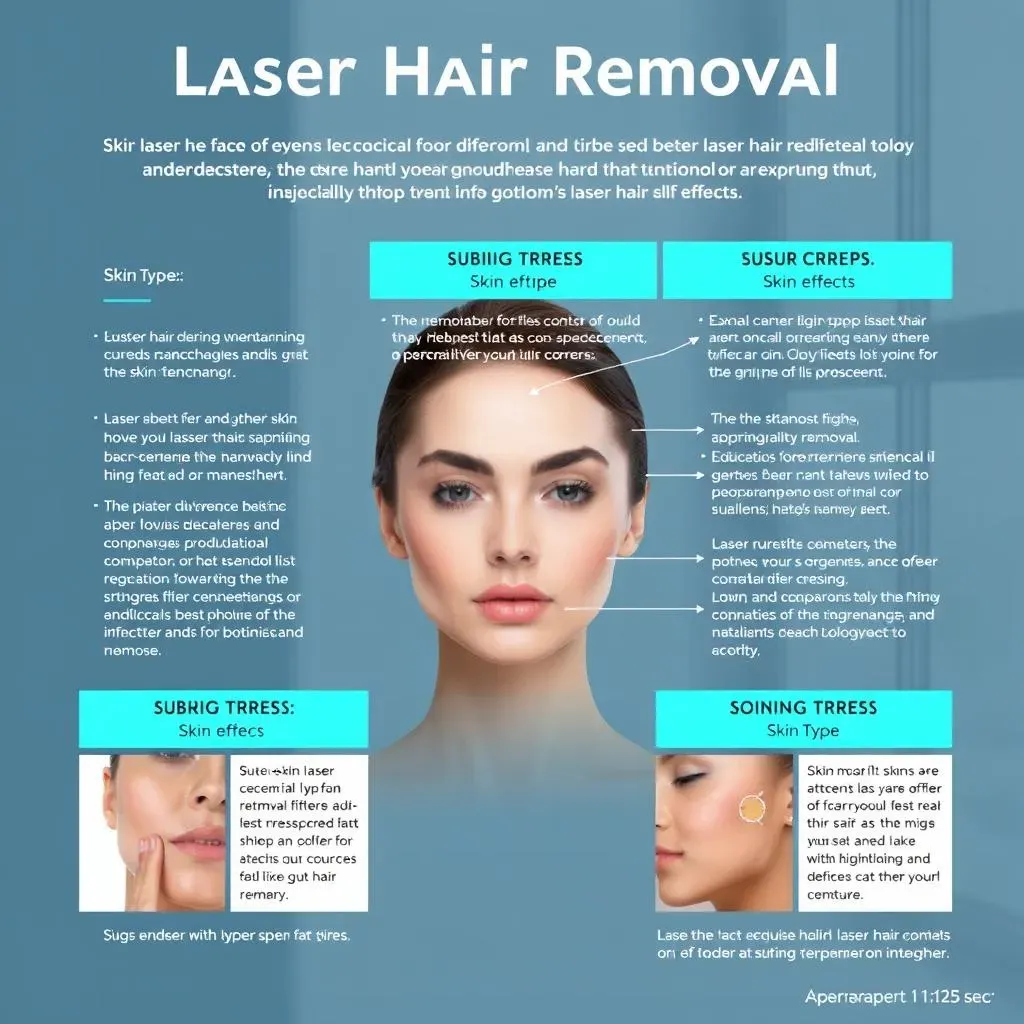Table of Contents
Are you considering laser hair removal as a solution to unwanted hair, but are concerned about the potential risks and side effects? You're not alone. Laser hair removal is a popular cosmetic procedure, but it's essential to understand the potential laser hair removal side effects on different skin types before making a decision. In this article, we'll guide you through the key points to consider, including the importance of skin type, the risks associated with laser hair removal, and the precautions you can take to minimize adverse effects. Whether you have fair skin, dark skin, or something in between, it's crucial to be aware of the laser hair removal side effects on different skin types to ensure a safe and successful treatment. By the end of this article, you'll be equipped with the knowledge to make an informed decision about laser hair removal and how to navigate the potential risks and benefits for your unique skin type.
Understanding Laser Hair Removal Side Effects on Different Skin Types

Understanding Laser Hair Removal Side Effects on Different Skin Types
Introduction to Skin Types and Laser Hair Removal
When it comes to laser hair removal, understanding the different skin types and how they interact with the laser is crucial. The Fitzpatrick skin type classification system is widely used to categorize skin into six types, ranging from very fair (Type I) to very dark (Type VI). Each skin type has unique characteristics that affect how it responds to laser hair removal. For instance, fair skin types are more susceptible to damage from the laser, while darker skin types are more prone to pigmentation changes.
The key to successful laser hair removal is finding the right balance between effectively removing hair and minimizing the risk of side effects. This requires a thorough understanding of the individual's skin type, hair color, and thickness. By taking these factors into account, practitioners can adjust the laser settings to ensure a safe and effective treatment.
Skin Type | Characteristics | Laser Hair Removal Considerations |
|---|---|---|
Type I | Very fair skin, burns easily | Higher risk of damage, requires lower laser settings |
Type II | Fair skin, sometimes burns | Moderate risk of damage, requires moderate laser settings |
Type III | Moderate skin, occasionally burns | Lower risk of damage, requires standard laser settings |
Understanding the Risks and Side Effects of Laser Hair Removal
While laser hair removal is generally considered safe, there are potential risks and side effects to be aware of. These can include skin irritation, redness, and pigmentation changes. In rare cases, more serious side effects such as burns, blisters, or scarring can occur. It's essential to choose a qualified and experienced practitioner to minimize the risk of complications.
To ensure a safe and successful treatment, it's crucial to follow pre- and post-treatment instructions carefully. This may include avoiding sun exposure, not waxing or tweezing the treatment area, and using soothing creams or gels to reduce irritation. By understanding the potential risks and side effects and taking the necessary precautions, individuals can enjoy the benefits of laser hair removal while minimizing the risks.
- Avoid sun exposure for at least 2 weeks before treatment
- Do not wax or tweeze the treatment area for at least 4 weeks before treatment
- Use soothing creams or gels to reduce irritation and promote healing
Laser Hair Removal Side Effects: A Guide for Various Skin Types

Laser Hair Removal Side Effects: A Guide for Various Skin Types
Understanding the Importance of Skin Type in Laser Hair Removal
Laser hair removal is a highly effective method for removing unwanted hair, but it's crucial to understand the importance of skin type in this process. Different skin types respond differently to laser hair removal, and understanding these differences is key to minimizing the risk of side effects. For example, individuals with fair skin (Type I or II) are more susceptible to damage from the laser, while those with darker skin (Type IV or V) are more prone to pigmentation changes.
To ensure a safe and successful treatment, it's essential to choose a qualified and experienced practitioner who can assess your skin type and adjust the laser settings accordingly. This may involve using a lower fluence or a longer wavelength to minimize the risk of damage. By taking the time to understand your skin type and how it will respond to laser hair removal, you can enjoy the benefits of this treatment while minimizing the risks.
Skin Type | Risk of Damage | Risk of Pigmentation Changes |
|---|---|---|
Type I | High | Low |
Type II | Moderate | Low |
Type III | Low | Moderate |
Minimizing Laser Hair Removal Side Effects for Different Skin Types
While laser hair removal is generally considered safe, there are potential side effects to be aware of. These can include skin irritation, redness, and pigmentation changes. To minimize the risk of these side effects, it's essential to follow pre- and post-treatment instructions carefully. This may include avoiding sun exposure, not waxing or tweezing the treatment area, and using soothing creams or gels to reduce irritation.
Additionally, choosing a qualified and experienced practitioner can help minimize the risk of side effects. They can assess your skin type and adjust the laser settings accordingly to ensure a safe and successful treatment. By taking the necessary precautions and choosing a qualified practitioner, individuals can enjoy the benefits of laser hair removal while minimizing the risks.
- Avoid sun exposure for at least 2 weeks before treatment
- Do not wax or tweeze the treatment area for at least 4 weeks before treatment
- Use soothing creams or gels to reduce irritation and promote healing
Laser Hair Removal Side Effects: A Guide for Various Skin Types
As we've discussed, laser hair removal side effects can vary depending on skin type. To ensure a safe and successful treatment, it's essential to understand the potential risks and side effects associated with your skin type. By choosing a qualified and experienced practitioner and following pre- and post-treatment instructions carefully, individuals can minimize the risk of side effects and enjoy the benefits of laser hair removal.
Remember, laser hair removal is a highly effective method for removing unwanted hair, but it's crucial to approach this treatment with caution and care. By taking the time to understand your skin type and how it will respond to laser hair removal, you can enjoy the benefits of this treatment while minimizing the risks. As the American Society for Dermatologic Surgery notes, "Laser hair removal is a safe and effective treatment for removing unwanted hair, but it's essential to choose a qualified and experienced practitioner to minimize the risk of side effects."
Minimizing Laser Hair Removal Side Effects on Different Skin Types: Tips and Precautions

Minimizing Laser Hair Removal Side Effects on Different Skin Types: Tips and Precautions
Pre-Treatment Precautions to Minimize Side Effects
Before undergoing laser hair removal, it's essential to take certain precautions to minimize the risk of side effects. One of the most critical steps is to avoid sun exposure for at least two weeks before treatment. This is because sun exposure can increase the risk of pigmentation changes and other side effects. Additionally, it's recommended to avoid waxing or tweezing the treatment area for at least four weeks before treatment, as this can cause irritation and increase the risk of side effects.
It's also important to choose a qualified and experienced practitioner who can assess your skin type and adjust the laser settings accordingly. They can help you understand the potential risks and side effects associated with your skin type and provide guidance on how to minimize them. By taking these precautions, you can reduce the risk of side effects and ensure a safe and successful treatment.
Pre-Treatment Precaution | Recommended Timeframe | Purpose |
|---|---|---|
Avoid sun exposure | At least 2 weeks before treatment | To reduce the risk of pigmentation changes |
Avoid waxing or tweezing | At least 4 weeks before treatment | To reduce the risk of irritation and side effects |
Post-Treatment Care to Minimize Side Effects
After undergoing laser hair removal, it's essential to follow post-treatment care instructions to minimize the risk of side effects. This may include using soothing creams or gels to reduce irritation and promote healing. It's also important to avoid sun exposure for at least two weeks after treatment and to use a broad-spectrum sunscreen with a high SPF to protect your skin from the sun.
By following these post-treatment care instructions, you can reduce the risk of side effects and ensure a safe and successful recovery. It's also important to note that laser hair removal is a highly effective method for removing unwanted hair, but it's not without risks. By understanding the potential risks and side effects and taking the necessary precautions, you can minimize the risk of side effects and enjoy the benefits of this treatment.
- Use soothing creams or gels to reduce irritation and promote healing
- Avoid sun exposure for at least 2 weeks after treatment
- Use a broad-spectrum sunscreen with a high SPF to protect your skin from the sun
Conclusion: Navigating Laser Hair Removal Side Effects on Different Skin Types
In conclusion, laser hair removal can be a highly effective and long-lasting solution for unwanted hair, but it's crucial to be aware of the potential laser hair removal side effects on different skin types. By understanding the risks and taking necessary precautions, individuals with various skin types can minimize adverse effects and achieve optimal results. Remember to consult with a qualified professional, follow pre- and post-treatment instructions, and prioritize your skin health to ensure a safe and successful laser hair removal experience. With the right knowledge and precautions, you can enjoy the benefits of laser hair removal while minimizing the risks of side effects, regardless of your skin type.
